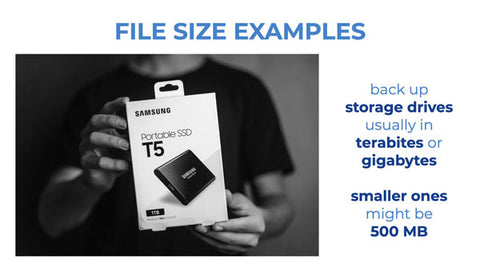When we are working digitally, a crucial thing to learn about are the size of files and the implications of this.

A file size is the measure of how much data a computer file contains or how much storage it consumes. Online is no different to offline. A large file with lots of paper in it will weigh more than a small file and take up more space on the shelf.
A similar thing will happen online, and in order to understand this we need to learn about the units that computers use.

As you can see here, the byte is the smallest unit.
We are usually working with kilobytes which are 1000 bytes, and that would be for small files, whereas a file in megabites would be for larger files and gigabytes would be for very large files.
Some hard drives will be in terabtyes or gigabytes and larger ones after that too.

Some examples:
My Amanya logo design is 103 kilobites, so that's a small file.
It's only got black and white colour information and its a simple design.
Whereas the Eat Me design has a lot more detail in colour and shape and is needed to be a bigger file to maintain the quality of this detail. This is 2.4 megabites so is over 23 times the size of the first file.
Most design files will be in megabytes but may be in gigbytes if they have a lot of detail.

Giving you some more examples, this is a Photoshop file which is 1.67 gigabtyes. It's a file in high resolution and it's scaled to use for large items so there's a lot of information in it.
This file is not suitable for use on the web.

This information is taken from the course 'File Types and Sizes' that is available for free for a limited time.
Here is a little more about what is included in the course:
You can see more about the course here:
https://amanyadesigncourses.com/p/file-types-and-sizes
For tips, advice and to get a peek into the adventures, be sure to hit the follow button and feel free to share with others on the links below!
Anna









